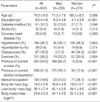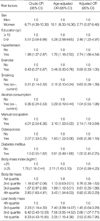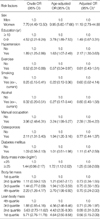1. Guccione AA, Felson DT, Anderson JJ, Anthony JM, Zhang Y, Wilson PW, Kelly-Hayes M, Wolf PA, Kreger BE, Kannel WB. The effects of specific medical conditions on the functional limitations of elders in the Framingham Study. Am J Public Health. 1994. 84:351–358.

2. Felson DT, Zhang Y. An update on the epidemiology of knee and hip osteoarthritis with a view to prevention. Arthritis Rheum. 1998. 41:1343–1355.

3. Cho NH, Kim S, Kim HA, Seo YI. The prevalence and risk factors of knee and hand osteoarthritis in Korea. J Korean Rheum Assoc. 2007. 14:354–362.

4. Park NG, Kim WK, Shin DH, Choi YM, Lee YJ, Lee EB, Kim HA, Kim YK, Park BJ, Hong SC, Song YW. Prevalence of osteoarthritis and rheumatoid arthritis in two communities in Korea. J Korean Rheum Assoc. 2003. 10:151–157.
5. Yun SH, Kang PS, Kim SB, Lee KS. Prevalence and related factors of knee osteoarthritis in rural woman. Korean J Prev Med. 2001. 34:331–336.
6. Min BH, Kim HS, Kim HW, Lee SY, Park JW, Kang SY. Epidemiology for Korean knee osteoarthritis: results from the health and nutritional survey in Kuri city. J Korean Knee Soc. 2000. 12:214–221.
7. Kellgren JH, editor. Atlas of standard radiographs of arthritis. 1963. Vol II. Oxford, England: Blackwell Scientific;15–33.
8. Korean Census. Korean Statistical Office, The Republic of Korean Government. 2000. accessed 11 July 2007. Available at
http://www.kosis.kr/index.html
.
9. Bellamy N, Buchanan WW, Goldsmith CH, Campbell J, Stitt LW. Validation study of WOMAC: a health status instrument for measuring important patient relevant outcomes to antirheumatic drug therapy in patients with osteoarthritis of the hip and knee. J Rheumatol. 1988. 15:1833–1840.
10. Nevitt MC, Peterfy C, Guermazi A, Felson DT, Duryea J, Woodworth T, Chen H, Kwoh K, Harris TB. Longitudinal performance evaluation and validation of fixed-flexion radiography of the knee for detection of joint space loss. Arthritis Rheum. 2007. 56:1512–1520.

11. Kothari M, Guermazi A, von Ingersleben G, Miaux Y, Sieffert M, Block JE, Stevens R, Peterfy CG. Fixed-flexion radiography of the knee provides reproducible joint space width measurements in osteoarthritis. Eur Radiol. 2004. 14:1568–1573.

12. Kellgren JH, Lawrence JS. Radiological assessment of osteoarthritis. Ann Rheum Dis. 1957. 16:494–502.
13. Altman RD, Hochberg M, Murphy WA Jr, Wolfe F, Lequesne M. Atlas of individual radiographic features in osteoarthritis. Osteoarthritis Cartilage. 1995. 3:Suppl A. 3–70.
14. Zhang Y, Xu L, Nevitt MC, Aliabadi P, Yu W, Qin M, Lui LY, Felson DT. Comparison of the prevalence of knee osteoarthritis between the elderly Chinese population in Beijing and whites in the United States: the Beijing Osteoarthritis Study. Arthritis Rheum. 2001. 44:2065–2071.

15. Yoshida S, Aoyagi K, Felson DT, Aliabadi P, Shindo H, Takemoto T. Comparison of the prevalence of radiographic osteoarthritis of the knee and hand between Japan and the United States. J Rheumatol. 2002. 29:1454–1458.
16. Hur NW, Choi CB, Uhm WS, Bae SC. The prevalence and trend of arthritis in Korea: results from Korea National Health and Nutrition Examination Surveys. J Korean Rheum Assoc. 2008. 15:11–26.

17. Kim HA, Kim S, Seo YI, Choi HJ, Seong SC, Song YW, Hunter D, Zhang Y. The epidemiology of total knee replacement in South Korea: national registry data. Rheumatology. 2008. 47:88–91.

18. Yau WP, Tang WM, Ng TP, Chiu KY. Factors leading to blood transfusion among Chinese patients undergoing total knee replacements: a retrospective study. J Orthop Surg (Hong Kong). 2004. 12:153–157.

19. Mitsuyasu S, Hagihara A, Horiguchi H, Nobutomo K. Relationship between total arthroplasty case volume and patient outcome in an acute care payment system in Japan. J Arthroplasty. 2006. 21:656–663.

20. Hart DJ, Doyle DV, Spector TD. Association between metabolic factors and knee osteoarthritis in women: the Chingford Study. J Rheumatol. 1995. 22:1118–1123.
21. Szebenyi B, Hollander AP, Dieppe P, Quilty B, Duddy J, Clarke S, Kirwan JR. Associations between pain, function, and radiographic features in osteoarthritis of the knee. Arthritis Rheum. 2006. 54:230–235.










 PDF
PDF ePub
ePub Citation
Citation Print
Print




 XML Download
XML Download